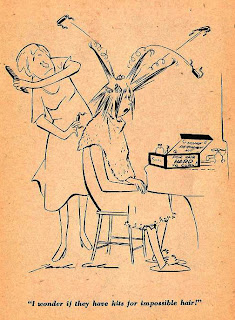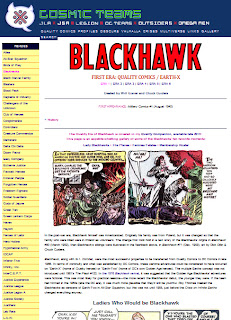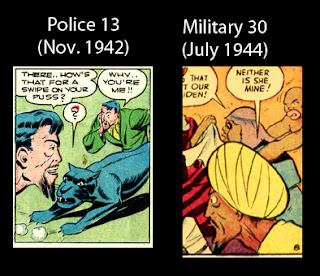The Jack Cole Christmas Cartoon Roundup: A Sprinkle of Playboy and a Dollop of Mirth!
A post made just 2 days prior to December 25th is the ideal place to share a Jack Cole Christmas story. After all, in his hundreds of comic book stories created in a 16-year career, there must be at least a handful of Christmas stories.
Right? I mean, the man was born in December (December 14th).
At least one Xmas story. Santa's gotta be in here, somewhere, right?
Nope.
To my knowledge, Jack Cole did not create a single Christmas-themed comic book story. Yet, he worked in an industry that delighted in exploiting the holiday for all it was worth, with numerous Christmas-themed stories and covers. What in the world does this say, if anything, about our friend and hero, Jack? Was he a bit of a humbug? Or, as a Methodist, was he reluctant to do much with the holiday out of respect? Perhaps Jack Cole was simply too much of an original to follow the pack and instead developed his own themes and subject matter.
Whatever the reason, Cole and Christmas just don't seem to mix. Take a look at this 1939 one-page Christmas cartoons, the one piece of Christmas-themed comic book work by Jack Cole that I have found:
 |
| Funny Pages Volume 3, Issue 10 (Dec 1939) |
As far as I can tell (somebody prove me wrong, please!), Cole doesn't touch on Christmas in his work again until 16 years later, after he's completely left comic books. In the December, 1955 issue of Playboy magazine, we find a Christmas card of sorts, by Jack:




It's one of five, and no doubt, Cole drew it as an assignment. Note that his card is accompanied by four others, all done by different Playboy artists.
Aside from the sprig of mistletoe at the top right corner of his card, and the understated hues of red and green (the colors of Christmas), there doesn't seem to be anything Christmas-y at all in the visual aspect of Cole's piece. This is even less enthusiastic about the holiday than his early 1939 page above. Nonetheless, his art leaps out of the pile of rather wooden art examples, and his concept is extremely clever and sexy. Here's the original art for this piece, a thing of beauty that celebrates the feminine, rather than the holiday:
Art Spiegelman, perhaps the most insightful critic of Cole's we have, has said somewhere that the key to understanding Jack Cole's work is to see that his main theme is impotence. My studies of Cole's work bears this out, and we'll see some examples of that later on in this posting.
However, it's worth noting that the above Playboy Magazine cartoon by Jack Cole is a rare portrait of masculine empowerment, rather than impotence. For this reason, it's always been a personal favorite of mine. A rare moment when Jack Cole stood up for his gifts and his own considerable power as an artist and generative human being.
In the image, the artist paints a slightly Christmas-y tie on the topless beauty. However, the image also looks a bit like the artist has created the stunning model of feminine sexuality with his brush and paints. And, of course, this is exactly what Jack Cole has done. In fact, in the original art scan, you can see his raw brushstrokes and paint daubs on the bottom edge of the board. Nice stuff. Thus, the image (especially the image of the original art) becomes a meta statement about the redemption Cole found in creativity, and perhaps in creating these ultimate images of the Feminine.
I also have in my files a lovely image of original art by Cole that looks as if it was created for a New Year's piece. I don't know if it was ever published. It's a lovely piece, a dazzling light and luscious vision.
In their terrific book, Forms Stretched to Their Limits: Jack Cole and Plastic Man, Art Spiegelman and Chip Kidd publish a very rare, delightful Christmas card drawn by Jack Cole in the mid 1940s for his New Castle, PA family (note the name on the mailbox of the home the singing letter is being delivered to):
Again, there's a fascinating dearth of traditional Xmas art. I'm not sure if this type of approach to a "Christmash" greeting is typical of the time. Perhaps, in the ensuing generations since the 1940s, us Americans have built up the Christmas tropes - Santa, reindeer, a manger, 3 wise men, Frosty the Snowman, and so on. I'm not sure. But even so, there seems to be something a little off about Cole's black-drenched celebration of the season of light.
That's about all the Christmas-themed Jack Cole stuff there seems to be. However, let's not end this post on a note of lack and darkness. In fact, I say let's let Jack Cole do what he did best, and cheer us up with some great cartoons.
I just yesterday discovered on scanner superstar Bchat's blog, M.O.D.M a curious little humor digest from March, 1955 called Mirth.
As you may recall, in the last few months, I've developed a theory that there are a lot of Jack Cole cartoons in 1954-55 publications that we have yet to discover. This was the period where Cole left a 16-year career in comic books and focused on magazine cartoons, which was a sort of parallel lesser career of his up until the mid-50's. Sure enough, this humor digest, scanned and shared by bchat (thanks!) has some Jack Cole in it.
In fact....
It's got TWELVE (!) Jack Cole cartoons in it! I could scarcely believe my eyes when I first paged through the book. This was a lovely gift from the Universe and I thought it would be nice to share these cartoons with everyone, as a sort of holiday offering.
In the inside front cover, we find this delightful captionless cartoon:
This is a super-clever use of negative space, and obviously the editor agreed, giving it the place of honor on the magazine, and choosing it out of the batch of 12 Cole gems he had in front of him. How in the world 12 Jack Cole cartoons were published in one emphemeral, vernacular bon bon is a mystery that will likely never be solved. My guess is that these cartoons of Cole's are mostly rejects from higher markets, and that Cole shoved an accumulation of these rejects into an envelope and mailed it to an editor with a smaller budget who knew a good thing when he saw it and snapped up the dozen gems.
Speaking of cartoons that -- um -- don't speak, here's another captionless cartoon by Jack Cole that I love:
Cole has wandered into the same territory as more gentle, observational cartoonists, such as Charles Schulz (Peanuts), and offers us a fascinating glimpse of what a mature Jack Cole could have done with cartoons, had he not gone the Playboy route.
Note the cartoons are all signed by Jack, in the same style signature he used for his Playboy cartoons. During this time, we find a number of "Jake" cartoons in the same sorts of magazines ("Jake" being Cole's pen name). Such as this beauty, also from bchat's website:
 |
| A-Laugh-A-Minnit #8(Toby Press/Minoan, circa 1955, exact date unknown) |
Note that this art looks similar to Cole's virtually unknown Millie and Terry comic strip, but it's also looser and more "arty."

Another interesting aspect to the Jack Cole Mirth cartoons is that they are not "Jake" cartoons. They reach out to other topics and situations, with grounded, more domestic humor instead of a frothy chiffon of sex. Consider this sitcom of a cartoon from the Mirth series:
This is truly inventive, clever, engaging stuff. It is very similar to Cole's Saturday Evening Post cartoon published about a year earlier:
Both cartoons are sequential multiple images, and both are about domestic squabbles involving lights at night. For more analysis of this particular cartoon, see my post here. Jack Cole liked drawing splashes of light and shadow, and we see this in a comic book work a lot:



Here's another cartoon from Cole's Mirth series that seems delightfully different from his men's magazine work; almost a George Price New Yorker style cartoon.
Here are the remaining delightful half-dozen Jack Cole cartoons from Mirth #36 (March, 1955). Thanks, Jack. Enjoy!
Cole's Comics wishes you all a happy holiday and a great 2012! Here's a silly card I drew for the kids and humbly offer.

















































